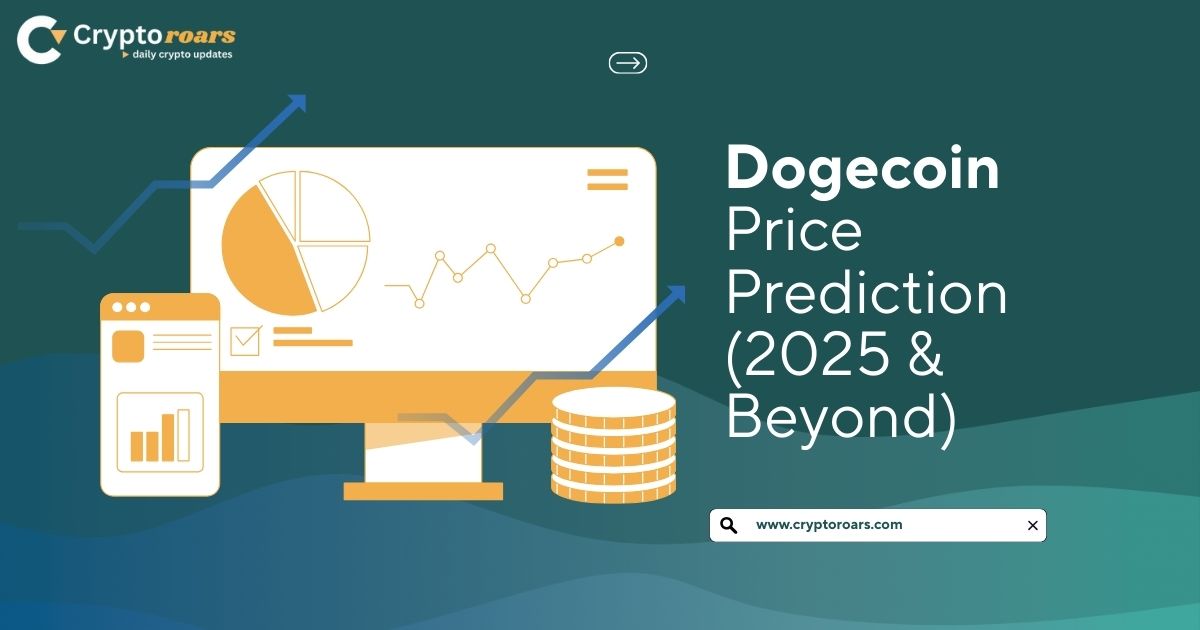When you hear the word Dogecoin (DOGE), you probably think of a joke coin that turned into a global sensation. At first, this parody cryptocurrency was meant to poke fun at the hype around Bitcoin (BTC) and Litecoin (LTC). But over the years, the Shiba Inu meme coin has built an identity that goes far beyond humor. It became part of internet culture, a meme-driven crypto that surprisingly holds billions in value and a passionate following called the crypto community (Doge Army).
This guide explains everything you need to know about coin—its origins, how it works, how to buy and mine it, the risks involved, and where experts see its future. Whether you’re a beginner or an experienced trader, by the end of this article, you’ll understand why this cult status cryptocurrency refuses to fade away.
What is Dogecoin?
Dogecoin is a peer-to-peer cryptocurrency that runs on an open-source blockchain. Unlike many other digital assets, Dogecoin doesn’t try to position itself as the most advanced or revolutionary project. Instead, it’s a simple payment coin that is cheap to send, fun to use, and backed by an extremely loyal community.
One thing that sets Dogecoin apart is its infinite coin supply. Unlike Bitcoin, which has a cap of 21 million coins, Dogecoin keeps producing new coins forever through mining. Each block adds 10,000 DOGE per block to the Dogecoin circulating supply (131.28 billion) and counting. That makes Dogecoin an inflationary cryptocurrency, but it also ensures there will always be enough supply for spending and tipping online.
The History
Dogecoin was created in 2013 by IBM & Adobe engineers (Billy Markus, Jackson Palmer). They forked the Litecoin codebase and replaced the branding with the famous Shiba Inu meme coin from the “Doge” meme. The goal was never to compete with Bitcoin (BTC) but to build a fun and welcoming crypto for beginners.
Despite its playful start, Dogecoin quickly gained traction. In 2014, it shocked the world when the crypto community (Doge Army) raised thousands in fundraising with Dogecoin to sponsor the Jamaican Bobsled Team sponsorship for the Winter Olympics, and later even a NASCAR sponsorship (Josh Wise). These events cemented Dogecoin’s reputation as a people’s coin—used for charity, tips, and internet fun.
Key Features
Dogecoin might seem simple, but its features make it different from other coins. For starters, Dogecoin uses the proof-of-work protocol with the Scrypt algorithm. That makes it faster and less energy-intensive than Bitcoin mining. Its block confirmation time (1 minute vs Bitcoin’s 10 minutes) allows for quick transactions, which is a big reason people love using it for micro-payments.
Another feature is Dogecoin’s strong decentralized network of Dogecoin network nodes and miners. While it’s often seen as lighthearted, the infrastructure is robust, securing the blockchain ledger system against the most common attacks. However, because of its relatively lower hash power distribution, there have been concerns about the potential 51% attack risk if a large mining pool gained control.
How Does it Work?
At its core, Dogecoin runs like other cryptocurrencies. Transactions are recorded on a decentralized ledger maintained by thousands of computers worldwide. Miners validate these transactions by solving math puzzles, using crypto mining hardware (CPU, GPU, ASIC).
Dogecoin’s mining is merge-mined with Litecoin. This means miners can secure both blockchains at the same time, improving stability. The incentive to miners comes in the form of mining rewards, which are set at a fixed 10,000 DOGE per block. This ensures ongoing supply but also adds to price volatility in crypto markets.
| Feature | Dogecoin (DOGE) | Bitcoin (BTC) | Litecoin (LTC) |
| Block Time | 1 minute | 10 minutes | 2.5 minutes |
| Supply | Unlimited (inflationary supply) | 21 million capped | 84 million capped |
| Algorithm | Scrypt algorithm | SHA-256 | Scrypt |
| Current Supply | 131.28 billion DOGE | ~19 million BTC | ~74 million LTC |
How to Buy Dogecoin
If you’re in the USA, buying Dogecoin is as simple as opening an account on a popular cryptocurrency exchange. Platforms like Coinbase, Binance.US, and Kraken allow you to trade USD for DOGE. Many retail traders in America also purchase Dogecoin through Robinhood traders, who helped drive its 2021 surge.
When buying, you’ll need a safe place to store your DOGE. This is where crypto wallets (hot & cold) come into play. A hot wallet is connected to the internet, making it convenient but less secure. A cold wallet is offline and protects your DOGE from hackers. Most serious investors use a combination of both crypto storage solutions (hot wallets, cold wallets) to stay safe.
How to Mine it?
Mining Dogecoin remains popular among enthusiasts. Unlike Bitcoin, where specialized ASICs dominate, Dogecoin can be mined using a wider range of crypto mining hardware (CPU, GPU, ASIC). Still, to be competitive today, you’ll need ASIC miners for Dogecoin.
Most miners join Dogecoin mining pools like Multipool, Prohashing, Antpool, Nicehash, and Genesis Mining to combine computing power and share the mining rewards. Since Dogecoin uses the Scrypt algorithm, it allows for efficient mining alongside Litecoin. This merge-mining approach increases the hash power distribution and strengthens both blockchains.
Dogecoin as an Investment
Investing in Dogecoin comes with opportunities and risks. On one hand, it has a proven track record of gaining massive attention due to Elon Musk’s tweets and social media influence (Reddit, Twitter). On the other hand, its price volatility in crypto markets makes it unpredictable.
Dogecoin reached its all-time high price ($0.7376) in May 2021, fueled by hype from WallStreetBets’ influence, retail investors, and Musk’s famous “to the moon” tweets. Those who bought early enjoyed massive ROI (Return on Investment), but those who bought at the top faced painful losses.
Price Prediction (2025 & Beyond)

Predicting Dogecoin’s future price is tricky, but analysts often consider adoption, supply, and community support. Some experts believe that Dogecoin could retest its previous highs if another bull market happens, especially if retail adoption of Dogecoin grows and it gains more use in payments.
Others warn that its inflationary supply makes it hard for Dogecoin to hold long-term value compared to capped assets like Bitcoin. Still, its strong branding as the original meme-driven crypto and cult status cryptocurrency may allow it to keep surprising skeptics.
| Year | Optimistic Prediction | Conservative Prediction |
| 2025 | $0.50 – $0.75 | $0.15 – $0.25 |
| 2030 | $1.00+ | $0.25 – $0.40 |
Risks, Challenges & Regulations
Dogecoin isn’t risk-free. As an inflationary cryptocurrency, the constant supply of 10,000 DOGE per block means dilution for holders. Combined with price volatility in crypto, it can be risky for those seeking stable returns.
Regulation in the USA also adds uncertainty. The SEC has started paying closer attention to meme coins and platforms offering them. If stricter laws come, the risks of Dogecoin investment could rise, especially for smaller retail investors / Robinhood traders.
Future of Dogecoin in the Crypto Market

The big question is whether it has staying power. Many experts see it less as a competitor to Bitcoin and more as a cultural symbol. Its crypto tipping on Reddit and Twitter, history of sponsorships, and community-driven events prove that it thrives on engagement rather than scarcity.
Its future may depend on whether businesses adopt it. If retail adoption of Dogecoin continues and more merchants accept it, DOGE could shift from being a parody cryptocurrency to a practical digital cash system on a decentralized network.
Final Thoughts
Dogecoin started as a joke but became one of the most recognized cryptocurrencies in the world. From Jamaican Bobsled Team sponsorship to Elon Musk’s “to the moon” tweets, its journey has been nothing short of extraordinary. While it may never rival Bitcoin in scarcity or Ethereum in technology, Dogecoin has carved out its lane as the internet’s favorite coin.
If you decide to buy, mine, or trade Dogecoin, remember the risks. But also remember its unique power—the ability to bring people together in ways few other coins can. That’s why the crypto community (Doge Army) continues to say with pride: Dogecoin isn’t just money, it’s culture.
FAQs
-
Is Dogecoin a good investment for beginners?
Dogecoin can be an entry point for beginners because it’s cheap and widely available on cryptocurrency exchanges. However, like any meme-driven crypto, its price volatility in crypto markets means you should only invest what you can afford to lose.
-
Can Dogecoin reach $1 again?
Dogecoin once touched its all-time high price ($0.7376) in 2021. Whether it hits $1 depends on Elon Musk’s tweets, community adoption, and overall market capitalization of Dogecoin. Experts believe it’s possible but not guaranteed.
-
How do I store Dogecoin safely?
You can store Dogecoin in crypto wallets (hot & cold). Hot wallets are convenient for frequent use, while cold wallets provide stronger security against hacks.
-
Is Dogecoin mining still profitable in 2025?
Mining Dogecoin is possible using ASIC miners for Dogecoin or GPUs with the Scrypt algorithm. Profitability depends on hash power distribution, electricity costs, and the Dogecoin mining pools you join.
-
Why is Dogecoin called the Shiba Inu meme coin?
Dogecoin started as a parody cryptocurrency inspired by the famous Shiba Inu meme coin image. Its fun origins helped it gain a cult status cryptocurrency reputation in the crypto community (Doge Army).
-
What makes it different from Bitcoin?
Dogecoin uses a proof-of-work protocol but has a block confirmation time (1 minute vs Bitcoin’s 10 minutes) and an inflationary supply (10,000 DOGE per block). Unlike Bitcoin (BTC), Dogecoin has no maximum limit, making it an inflationary cryptocurrency.
For more information, keep visiting cryptoroars.com


